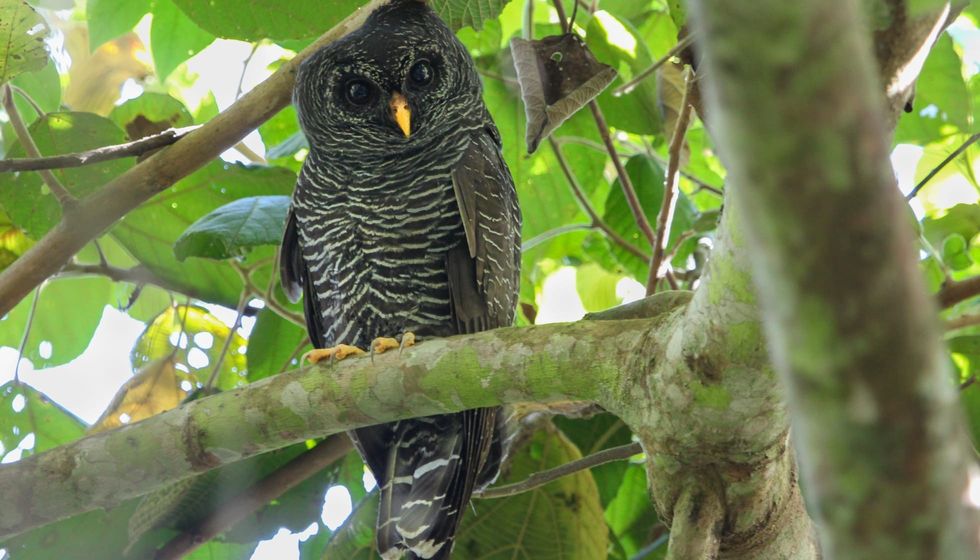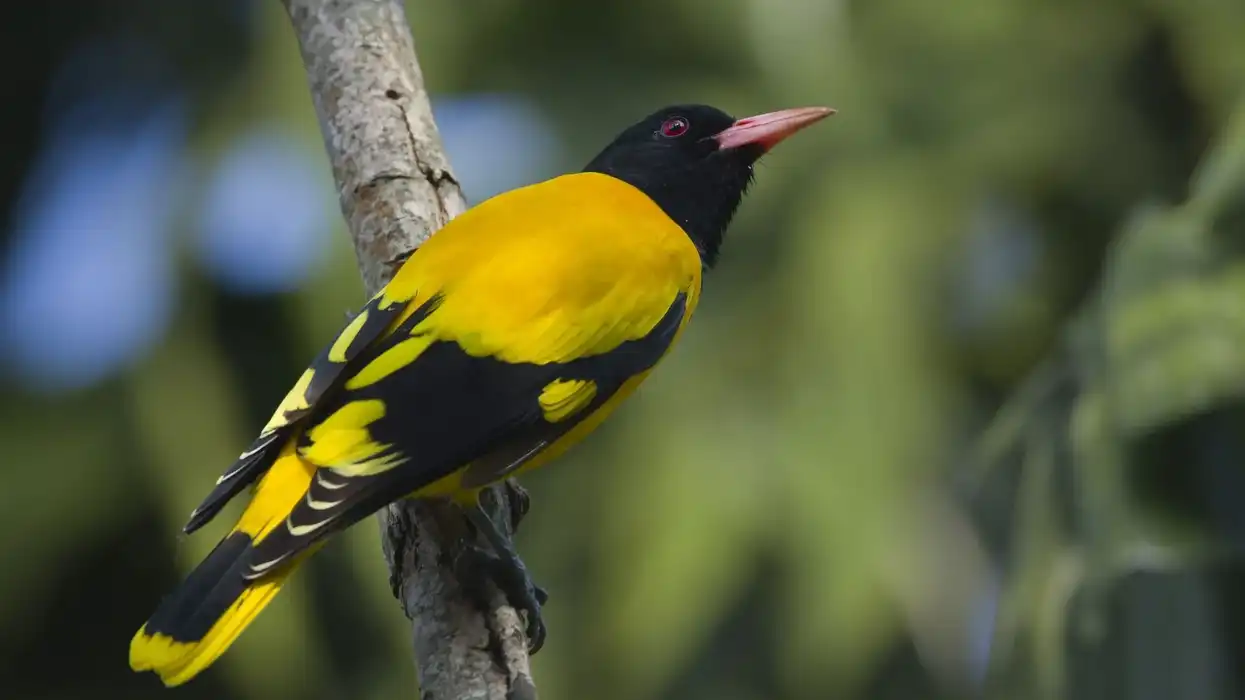The black-banded owl was previously known as Ciccaba huhula but later the entire genus changed and the species was combined with Huhula strix. The black-banded owl belongs to the order Strigiformes, family Strigidae.
They are called Cárabo negro in Spanish. The distribution of these medium-sized neotropical birds is scattered around South America. Their population is distributed in places like Argentina, Bolivia, south and east Brazil, eastern Paraguay, Peru, east of the Andes, Suriname, and French Guinea.
Their habitat is in sub-tropical forest, tropical montane forest, and moist lowlands. They are occasionally found near coffee and banana plantations.
They are of the color combination black and white. This species of owl has dark brown to brown eyes, yellow or orange feet, yellow-colored bill, and the feathers go down to their toes.
The face is roundish and is dark gray or blackish in color. The body has horizontal dense white bars.
The tail is mostly black but has a few narrow white bars in it. The black-banded owl juvenile is more heavily barred than the adults. During the breeding season, the males make several vocalizations to attract the female.
The diet of this bird species consists of large insects like beetles, grasshoppers, and small vertebrates. This bird species has a stable population and is given the status of Least Concern by the IUCN Red List.
If you like this article on black-banded owls, check out these other articles on tawny owls and red owls.
Black-Banded Owl Interesting Facts
What type of animal is a black-banded owl?
The black-banded owl is a type of owl.
What class of animal does a black-banded owl belong to?
The black-banded owl (Strix huhula) belongs to the class called Aves. Other owl species in this genus include the spotted wood owl and barred owl.
How many black-banded owls are there in the world?
The exact number of black-banded owls has not been listed.
Where does a black-banded owl live?
The back-banded owl is a native to South America, east of the Andes Mountains. It is found in Colombia, Bolivia, south-eastern Brazil, Paraguay, Venezuela, Suriname, Ecuador, French Guiana, Peru, and Argentina.
What is a black-banded owl's habitat?
This species of black-banded owl is found in subtropical and neotropical forests, moist lowlands, and tropical moist montane forests. They are occasionally found near coffee and banana plantations.
Who do black-banded owls live with?
The black-banded owl (Strix huhula) or the Cárabo negro in Spanish is a solitary animal in most cases. However, they are sometimes spotted in small groups when the breeding season is over. A group of black-banded owls is called a parliament.
How long does a black-banded owl live?
The black-banded owl (Strix huhula) live for around 20 years in the wild. In captivity, this species of black-banded owl is known to survive for around 29 years.
How do they reproduce?
The black-banded owl (Strix huhula) is dioecious in nature, meaning that this species has distinct males and females. The male black-banded owl is known to call the female black-banded owl in seven different descending notes.
The females usually respond to these calls with similar-sounding notes. After the egg is laid, the incubation period is from September to November.
During this period, the egg is incubated all day long and even all night except for occasional gaps which last for five to 10 minutes. Even after the egg hatches, similar behavior is observed for the next three weeks.
The females are the ones who are observed incubating the eggs and brooding them. However, both males and females take the responsibility of protecting their nest from any kinds of external attacks.
What is their conservation status?
The black-banded owl (Strix huhula) has been given the status of Least Concern by the IUCN Red List. However, it has been observed that the population of black-banded owls is rapidly decreasing because of deforestation and logging.
There has been a 30% decline of its entire population over the last three generations. If the decline in its population rate stays at more than a 10% rate, this species might become Vulnerable in the future.
Black-Banded Owl Fun Facts
What does a black-banded owl look like?
The black-banded owl (Strix huhula) is black in color and has white concentrated, horizontal, white wavy bars. The color of their eyes can range from brown to dark brown and the color of their bill ranges from yellow to orange.
The initial feathers are of a darker shade than the rest. The forehead and the crown have dense white bars.
The base of the feet has black and white feathers. The feet are yellow in color.
The tail feather is mostly black in color with a few narrow white stripes This black-banded owl and the black and white owl species look similar, except the former is blacker in its body and has a lot more concentrated white bands. Their primary feathers are much darker than the other feathers.

* Please note this is an image of a burrowing owl from the same family as the black-banded owl. If you have an image of the black-banded owl, please let us know at hello@kidadl.com.
How cute are they?
The black-banded owl (Strix huhula) has black and white feathers all over its body. Their roundish face, dark gray and black feathers, dense narrow white bars on the forehead, and dark brown to brown eyes add to their cuteness factor.
This medium-sized species of tropical birds have white, horizontal, wavy bars all over their bodies. The orange or yellow-colored bill and feet and feathered black and white toes also make them look adorable.
How do they communicate?
The black-banded owl (Strix huhula) or Cárabo negro in Spanish, communicate with each other using a series of vocalizations. The song sung by the male owl of this species consists of a series of changing hooting sounds.
These black and white feathered birds make three or four guttural sounds, followed by a pause that is of is almost half of a second. This rhythm is preceded by small and long hoots. During the nesting period, the black-banded owl communicates with different kinds of screeching sounds.
How big is a black-banded owl?
The black-banded owl size is 14-16 in (35.4-40.6 cm) long.
How fast can a black-banded owl fly?
The black-banded owl (Strix huhula) flies at a speed of 31-37.2 mph (50-60 kph). They are slower than the great horned owl, which are considered to be one of the fastest owls.
How much does a black-banded owl weigh?
An adult black-banded owl (Strix huhula) weighs around 15.8 oz (450 g). They are 12 times heavier than the elf owl.
What are the male and female names of the species?
No specific names have been given to the males and females of this medium-sized subtropical bird.
What would you call a baby black-banded owl?
A baby black-banded owl is called a chick.
What do they eat?
A black-banded owl, whose scientific name is Strix huhula, eats large insects, moths, grasshoppers, beetles, and cockroaches. On different occasions, they are also seen feeding on small vertebrates like bats.
Are they poisonous?
The black-banded owl (Strix huhula) is not considered poisonous.
Would they make a good pet?
The black-banded owl (Strix huhula) is a wild animal which doesn't make them suitable for pets. The natural instinct of this species of owl is to hunt which makes them uneasy in confined spaces.
Did you know...
The San Isidro owl is thought to be a closely related subspecies of the Strix huhula. It may also be a related subspecies of another variety of owl, called the black and white owl or it is in between the two subspecies.
The population distribution of the black-banded owl is scattered throughout South America. They are found in south Venezuela, east Peru, south Bolivia, east Ecuador, Argentina, and south-east Brazil.
The habitat of the black-banded owl is in lowlands and tropical and subtropical forests. Their habitat also includes coffee and banana plantations.
In one in a million cases, barn owls can actually be born with black feathers due to a genetic condition. These black owls are generally considered very rare. They should not be confused with a black-banded owl, which is a different species of owl.
What is unique about black-banded owls?
The black-banded owl (Strix huhula) has a unique appearance. This species of bird looks quite similar to another species of owl called the black and white owl but the former has horizontal white bands on its body.
They have dark brown to brown eyes and feathers that extend to their toes. This bird species is native to South America and the range of this bird species extended to different countries like Brazil, Argentina, Peru, and Ecuador.
Earlier the genus of this bird species was Ciccaba but now it falls under the Strix genus. The bird belonging to the order Strigiformes, family Strigidae has the description of its appearance and characteristics that is closely related to the San Isidro Owl.
Are black-banded owls endangered?
This species is not considered endangered. It has more or less a stable population range across South America and is considered of Least Concern by the IUCN Red List.
Here at Kidadl, we have carefully created lots of interesting family-friendly animal facts for everyone to discover! Learn more about some other birds from our Anhinga facts and umbrellabird facts pages.c
You can even occupy yourself at home by coloring in one of our free printable black banded owl coloring pages.










